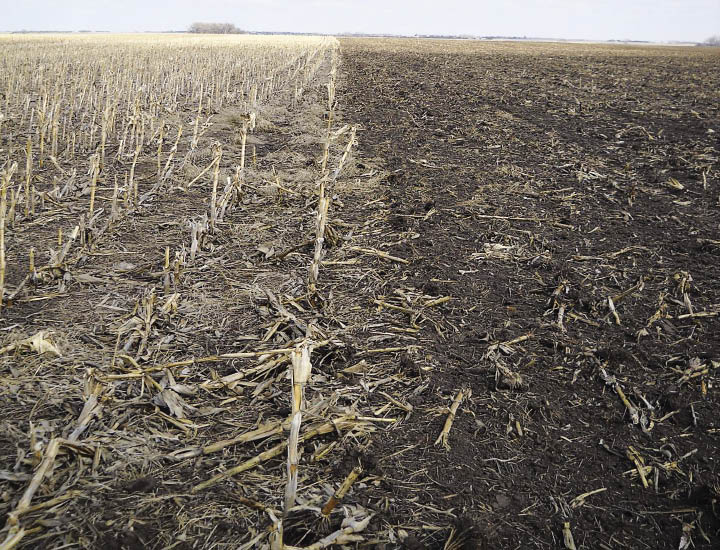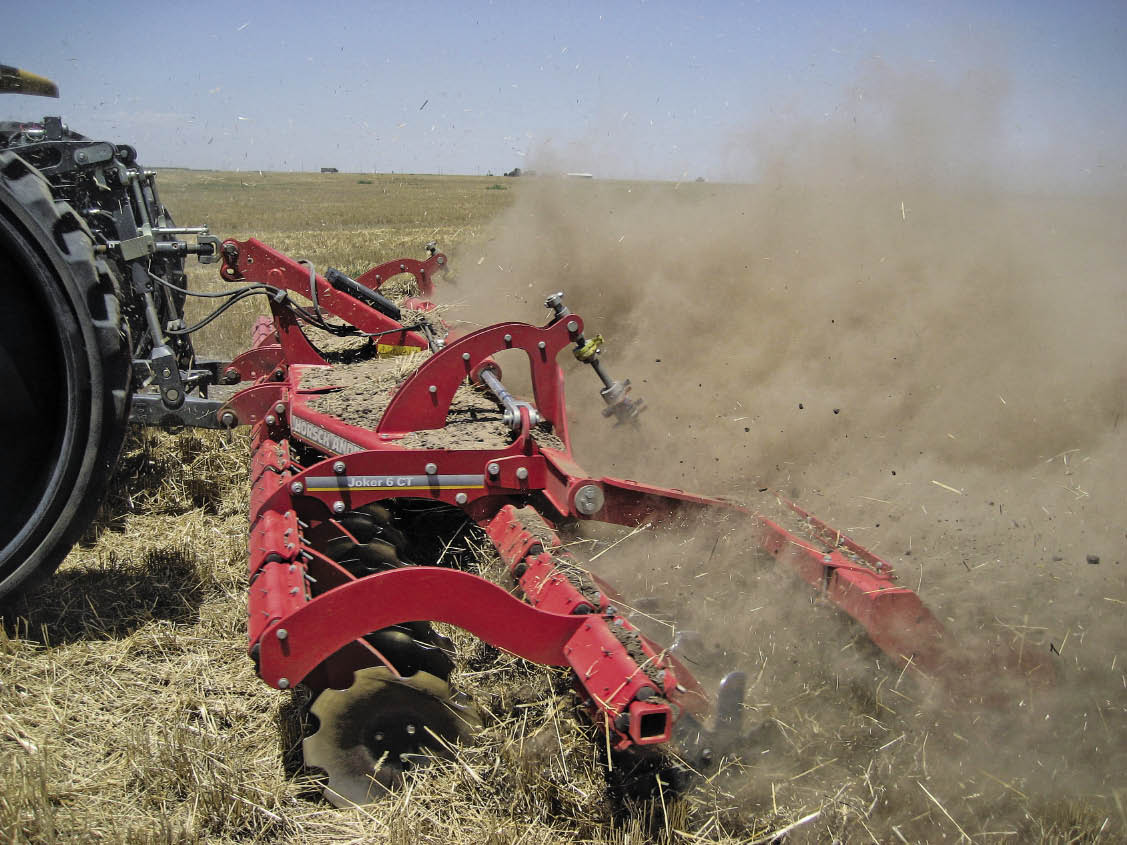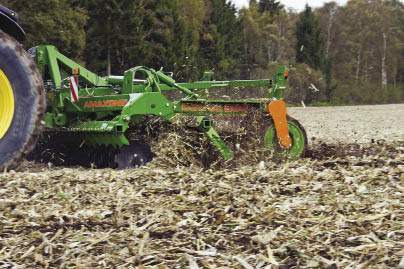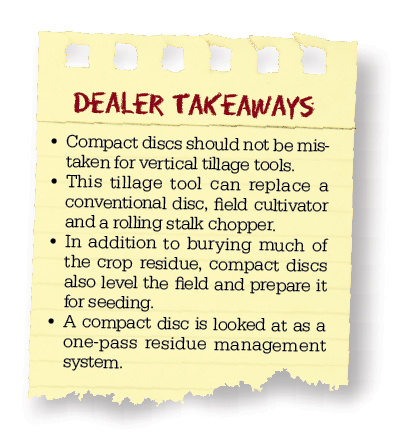They may not agree on what to call this new implement, but the dealers who are already carrying it do agree that what it’s bringing to the farm field will likely make it the next big thing in tillage equipment. The manufacturers Farm Equipment spoke with generically refer to it as a “compact disc.”
The compact discs that are being introduced to the North American market are designed to size crop residue and mix it with soil to speed its decomposition. It also levels the soil and prepares it for seeding. These implements are also effective for incorporating fertilizer.
But Tom Wald of Butler Machinery in Bismarck, N.D., isn’t in the camp that calls it that. “It’s more of a vertical tillage tool,” he says. “I can understand why you might look at it and say it’s just a little disc, but it’s a whole lot more than that. It’s more of a ‘high speed minimum-till’ tool. Actually the gentleman who invented it probably nailed it the best and he called it a ‘no-tiller’s tiller.’ It’s a real shallow working, high-speed tool.”
On the other hand, Mike Laethem, co-owner of Farm Depot in Caro, Mich., prefers that the compact disc not be mistaken for vertical tillage.
“To me, vertical tillage equipment has coulters, runs straight and cuts stalks and a slot in the ground. But it doesn’t move dirt left and right the way a compact disc does. This equipment cuts stalks and thoroughly levels the soil. It also thoroughly mixes the top 2 or 3 inches of soil, and you can run it deeper if you want. It does much more than vertical tillage. I think ‘compact disc’ is a good way to describe it,” Laethem says.
Dave Flowers of Flowers Equipment, a distributor for A.M.S. Incorporated, the North American importer of Amazone machinery, offers this middle-of-the road definition. “It’s a one-pass residue management system that falls ‘loosely’ under the category of vertical tillage,” he says, “except it isn’t vertical because you have one disc coming in at a 17 degree angle and another movable disc opposing it at a 14 degree angle.”
Cory Weiss, who is an ag salesman for McFarlanes in Sauk City, Wis., says, “It isn’t vertical, it’s basically horizontal because the concave discs move the soil sideways where vertical tillage basically works it vertically.”
When you get beyond the differences in terminology, neither dealers nor manufacturers disagree about the equipment’s potential for improving the farmer’s tillage efficiency or increasing dealers’ sales.
What’s a Compact Disc?
The construction and design of these units vary somewhat by brand, but each are designed to chop crop residue and cover it with some soil to enhance its decomposition. As such, the equipment is reportedly also effective at incorporating fertilizer.
The concept and design of compact discs originated in Europe and they have been used extensively on European farms for a decade or more, according to Jeremy Hughes of Horsch Anderson. Along with Amazone of Germany, which builds the Catros, and Poettinger of Austria, that offers the Terradisc, Horsch Anderson, a German-American company that builds the Joker, is introducing compact disc tillage to North American farmers.
According to Hughes, the reference to “compact disc” comes from the shorter “contour depth” of the implement compared to most conventional discs.
“With our equipment, we’re looking at maybe 5 or 6 feet, if that. A conventional disc often can be 10-12 or even 14 feet deep depending on the size of the disc.”
Compared to a conventional disc, Hughes says, the tighter frame of the compact disc allows it to cover a wide range of field conditions and terrain, yet maintain the consistent depth needed for seedbed preparation.
Laethem adds to the equipment’s description by explaining that it’s a “high speed disc with no gang bolt. Because it has no gang bolt, it’s nearly impossible to plug. We’ve gone through 3-inch tall standing wheat without plugging.”
Adding to Laethem’s description, Wald says, “The design consists of 20-inch blades mounted on a single, independent torsion arm, with no gang shaft like you’d see on a regular disc. The torsion arms allow for independent action for each blade and compensates for varying ground conditions.”
Anders Hansen of Poettinger, says, “In addition to the side discs that leave the soil level and ready for planting, it also has a set of leveling tines behind the last row of discs. This moves some soil up in the air and does a good job of leveling it in the driving direction. These can be adjusted in height and angle so the farmer can make it work in pretty much any condition.”
Flowers explains that Amazone calls the mechanism that follows the discs on its units a “wedgering roller.”
“It’s a roller made of rubber rings, similar to an oversized O-ring and spaced by poly spacers. This wedgering roller leaves a special pattern on the soil that prevents capping and, to a point, erosion.
“This design allows users to start a little earlier and run a little longer on wet fields since this roller is self cleaning. Typically this type of machine will cover about 60% of the crop residue and leaves about 40% on top. The wedgering roller tucks the above ground residue into the ground a bit to prevent blowing in the winter,” says Flowers.
Jac Knoop of A.M.S. Incorporated, adds that dealers he’s spoken with most often ask about working width of the equipment. He says he’s delivered machines to the North American market that include trailed versions from 10-40 feet, and 3-point versions from 10-20 feet.
Typically, a compact disc will cover about 60% of the crop residue with soil and leave about 40% of the residue on top, preventing it from blowing away and aiding in moisture retention. In addition to side discs that level the soil and ready it for planting, leveling tines and/or rollers further prepare the seedbed.

Operational Nuances
Putting their reference to “high-speed” tillage tool into context, dealers report the optimal speed is between 8-12 mph, but some say they’re seeing them run at 7-14 mph. “If you go any slower than 8 miles an hour, it really doesn’t do a very good job,” says Jon Yost of Yost Farm Supply in Goodland, Kan. “The speed needs to be kept up for the unit to work best.”
Likewise, he adds, anything over 11 or 12 mph doesn’t seem to make much difference. Most brands of compact discs use either a 20-inch notched or solid blade.
With this equipment, says Yost, “there’s not the concavity in the blades as is typical with a conventional disc harrow and it can utilize notched blades. This really appeals to the no-till guys because it doesn’t create the compaction like a regular disc does.”
Laethem, on the other hand, leans toward solid blades. “We sell both notched and solid, but I prefer the solid because I don’t want to miss anything,” he says. “The argument I’ve heard for notched is that they cut better, but we’re getting complete cutting with the solid blades.”
In terms of horsepower required for peak operation, Weiss has found about 12 horsepower per foot of disc is required.
“For us here in south central Wisconsin where we’ve got a few hills, a 20-foot compact disc takes all of 250 PTO horsepower,” he says. “If you’re on flat land, you’d probably get by with a 220 or 240 horse tractor.”
How Farmers are Using It
Dealers refer to the compact disc as a shallow working, high-speed, one-pass residue management tool. They also report that it can replace a conventional disc, field cultivator and a rolling stalk chopper.

While they may refer to it by different names, each of the dealers Farm Equipment spoke with say customers are finding this minimum-till tool to be far more versatile than anticipated. From alfalfa to wheat and pastureland to Conservation Reserve Program (CRP) acres, compact discs appear to be finding many homes. Differences in soil type have proved to be inconsequential.
The Dakotas: A Surprising Market. Tom Wald of Butler Machinery, in particular, says customers have been “wowed” by the job the compact discs are doing. When he was first introduced to compact discs, he didn’t see the equipment as an opportunity to grow sales in his area.
“I’ve been selling farm equipment in western North Dakota for 18 years and I never imagined this was a tool I could sell in my territory. I felt it was for the corn guys and farmers working in wet areas. Interest in it is 50 times more than I ever thought it would be,” Wald says.
He says that the market for the equipment throughout Butler’s sales coverage area in the Dakotas is very promising. “The area around Aberdeen, S.D., has been particularly strong. We take them out and let guys try them and they don’t leave the farm.”
Wald’s customers range from cattle ranchers to wheat producers that work 15,000 to 25,000 acres. Most are dedicated no-till and minimum-till farmers, he says.
“I had a couple brothers who wanted to work their wheat stubble, borders and the ends of their fields. They had some weeds to clear up and needed to level some canola ground. They wanted to work the top inch or inch and a half and blacken up the field a little bit, but leave some stubble to catch the snow,” Wald explains.
“We set the compact disc about a half an inch deep and they were absolutely tickled with the results.”
In another case, Wald loaned a compact disc to a farmer last fall who had just ordered a new John Deere medium-duty disc. For the better part of a day the farmer followed the combine during harvest and worked the corn stubble down. “The next morning he cancelled the order on the big Deere disc and ordered a compact disc from us.”
Some farmers who have used the equipment work a field at one angle, then come back and work it again at a different angle, according to Wald. But for the most part, it’s used as a one-pass tool that produces an excellent and level seedbed for planting. “Fields worked with these discs have a tendency to warm up a little faster so growers can get in and get the crop seeded a little earlier.”
He adds that farmers have also found the compact disc to be particularly effective in eliminating ruts. “To get rid of sprayer tracks or where they might of gotten stuck with the combine, they literally fly over the top of the ruts, level everything out and they’ve got a nice level field for planting when they’re done.”
Western Kansas & Nebraska: Varied Crops & Soils. With 3 stores in Goodland and St. Francis, Kan., and Imperial, Neb., Yost Farm Supply serves a mixture of customers. Sunflowers, dryland and irrigated corn and wheat, and edible beans are among the major crops in its territory, with clay loam soils in Kansas and sandy soils at its Imperial store.
Jon Yost estimates the dealership has sold about dozen compact discs in the first year they’ve carried them. It’s typically used for sizing and managing crop residue, but they’ve found it’s been effective incorporating fertilizer, too.
“We have a lot of dryland wheat, and this tool does an outstanding job of incorporating both dry and liquid nutrients. We only run 2-3 inches deep and that’s what you need to get the job done. It’s nothing like a conventional disc where you bury it up to the hubs.”
The dealership sells several vertical tillage tools. Yost says compact discs are similar in operation and function, but produce different results.
“What you’re going for with a vertical tillage tool is basically the same thing you’re trying to do with the compact disc,” he says. “The thing with most vertical tillage tools is they don’t throw as much dirt.
“I had one farmer who used a vertical tillage unit and the stalks ended up blowing off of the field. What really caught my eye with this equipment is the packer system on the back. It mixes the dirt with the residue and packs it back down so it won’t blow away as easily,” Yost says.
Because it promotes residue, Yost believes the dealership will develop sales with corn-on-corn no-tillers. “After several years, there’s so much residue building up they’re going to have to do something. I think they’ll find this tool is what they need without moving away from their no-till practices,” he says.
Yost says the dealership has customers who use the compact disc as a one-pass tool, while others do two passes and then strip-till immediately afterward. “A lot of times they’ll run it right before drilling and it does a real great job of seedbed preparation.”
The growing use of Bt corn has created challenges in managing residue. This is why it often takes two passes with the compact disc to get the stalks sized properly.
“Bt corn is tough to size and chop. If it’s dryland corn, it’s not as big of a deal. But if it’s irrigated, it’s not unusual to see stalks that are 2-plus inches in diameter. That’s tough stuff to manage. That’s why I say sometimes they have to run over it twice,” he says.
Another trend he seeing is farmers pulling acres out of CRP. In these instances, they make 2-3 passes with the compact disc since it’s especially effective in getting rid of weeds, burying residue and smoothing the field.
As far as the versatility of compact discs, Yost says there’s no doubt his customers can often use it in place of a conventional disc and a field cultivator. He also believes they will be able to eliminate the use of a rolling stalk chopper.
To be effective, dealers say this “high-speed” tillage tool needs to be operated between 8-12 mph to be effective. “It really doesn’t do a very good job” at speeds lower than this. Likewise, at speeds higher than 11 or 12 mph doesn’t seem to make much difference either.

Central Wisconsin: No-Till & Dairies — Most of McFarlanes’ customers are in livestock and dairying. Cory Weiss estimates 15-20% are grain producers. The dealership has sold compact discs for 2 years.
As for the terrain in the area, he says it’s as varied as almost anywhere in the country. “If you’re on the west side of the river, it’s sand. If you’re on the east side of the river it’s more clay with the stones,” he says.
Besides having a lot of no-tillers in the area, there’s obviously a lot of alfalfa grown and manure to be spread with sizeable dairy operations. According to Weiss, the compact disc is “great” for incorporating manure and getting a field ready for planting.
“This tool makes a very nice seedbed for our farmers that direct seed,” he says. “They’re looking for a very flat field when they’re done. They don’t want ridges or anything like that in their alfalfa fields because they have to drive over it 4 times a year at 12 miles an hour to cut it,” Weiss says.
The implement is particularly effective in his territory because of the rocky soil. “With its individual rubber torsion spring on the individual discs, our guys really like it because they don’t break disc blades and it leaves a very nice seedbed. Besides burying trash, the biggest thing around here is that it buries the stones and, doesn’t bring as many rocks up as a field cultivator or a tandem disc does.”
He also notes that the roller packers firms up the soil which helps minimize soil erosion.
Because the equipment is easily adjustable farmers find it extremely versatile for a range of tillage tasks, according to Weiss.
“Because it runs off of the 3-point hitch, the front is adjustable from the cab. Depending on what model you’re using, the rear depth adjustment might require pulling 3 or 4 pins to set the depth of the disc blades. From my experience, most run it in the spring and only go as deep as they’re planting, maybe an inch to 2 inches, depending on crop. The others till the ground in the fall to bury residue. They set it in the 2-3.5 inch range,” he says.
Lower Michigan: Doing Double Duty. In the 2 years Farm Depot has handled compact discs, Mike Laethem says the dealership has sold about 10 units throughout lower Michigan.
He says a major benefit of the compact disc is that it can accomplish two tasks at the same time. For example, farmers can place a seeding device on the back of it to plant cover crops.
“It’s a drill attachment that sits on top of the tool. The government’s paying people to plant cover crops and this is a perfect tool because you can plant your cover crop while you’re working it in. Or you can attach it to your manure tank and do both operations at the same time,” Laethem says.
“Most of our first adapters were no-till farmers who want to level their fields, mix the residue and soil to blacken the surface and increase residue decay without changing the soil structure they’ve built up. The next group needed to deal with Bt type corn residue to break down both the stalk and stump,” says Laethem.
About two-thirds of the Michigan growers are using it as a one-pass tool. The others are running it both in the fall and again in the spring.
He adds that it’s been a bit of godsend for no-tilled wheat. With the mats of residue building up, they were having trouble with slugs. According to Laethem, they did a pass with the Catros and it destroyed the slugs’ food source. The next year, they were gone.
While Laethem vouches for the compact disc’s effectiveness in rocky soil, he says the most impressive thing is it seems to work in all types of soil.
“We had one customer who used it in one field that had 4 types of soil. He said that’s the only implement he’s ever run that worked in all the soils, and he didn’t have to go back home to switch tools.”
All-in-One Tool
Hansen says the compact disc came about because European farmers were facing new challenges and were not satisfied with the results they were getting from conventional tools. “Like the Americans, Europeans are always looking for better ways to do the things.
“This is a more compact machine design to accomplish a lot in a single pass. With two rows of discs sitting closer together and at different angles along with the individual suspension and packer rollers, it allows us to precisely control the working depth. All of these things together make the work go faster with less fuel.
“In the end, it does a better job because it levels the soil and mixes it with the crop residue all in one pass. That’s really the short story when it comes to the compact disc,” says Hansen.








Post a comment
Report Abusive Comment